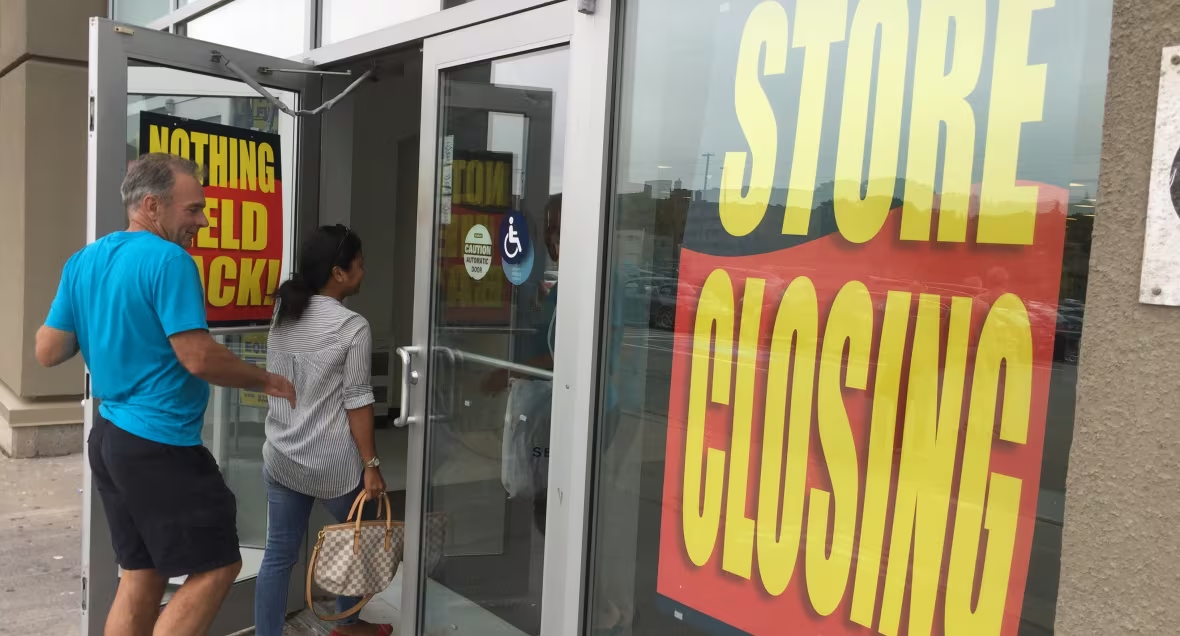Hudson’s Bay’s demise marks the death of the traditional department store in Canada

Hudson’s bay in the center of Vancouver already seems to be failed.
When they enter the shop, buyers are welcomed by warning signals that neither the lifts of the shop nor the escalator work and have to use the fire exit stairs.
The employees patrolly patrol the fragrance and cosmetic cabins without customers in sight.
The bay of Hudson was, for decades, an important destination for shopping, offering more fashion, accessories, furniture and appliances.
But now, it is likely that the same fate of other great warehouses in Canada is likely to meet such as Eaton’s and Sears, who have already closed the doors due to slow sales and debt mountains.
Hudson’s bay is Still keep hope He will find a buyer for everything or part of his business. But a more likely scenario is that the deeply indebted retailer will close soon and the liquidation sales will begin already this week.

The smaller versions of the department store model are still flourishing, such as the chain of discounts Walmart and the Canadian fashion dealer, Simons. But the iconic department store with window display and several floors of various goods is approaching Canada.
Some experts say that the reason, in the center, is simple: these detail giants have been blocked in tradition and have not changed with the times.
“They were trying to work with an obsolete model,” said the retail strategist David Ian Gray. “Only over time, it has become archaic.”
That feeling echoes to buyers who feel bad for the bay – and do not buy there.
“It is a bit sad that they are doing everything,” said David Genio outside the bay in the center of Vancouver.
But in the next breath, he added: “Their stuff is a little obsolete that I find and turn towards the elderly”.
Outside the bay in the center of Toronto, Cathy McCabe-Lokos agrees that the death of the chain is sad. But he also admits that the position “was empty, a little desolate for years”.

The intrusive specialty shop
The Eaton Center shopping center in Toronto is a microcosm for the death of the traditional department store. Opened 1977 with Eaton’s As still – one of the largest in Canada department store chains at that moment. However, Eaton’s declared failure in 1999after more than 100 years of activity.
The Sears department store giant took on space until 2017, when he met a similar and closed destiny. Nordstrom, based in the United States, then took over until 2023, when it is Extract from Canada due to late sales.
Gray states, starting from the 90s, two great shopping trends have helped the disappearance of the traditional department store: the growth of electronic commerce and specialty shops.
He says that the department stores have allowed buyers to browse a wide selection of goods and gave them access to the coveted brands that the smallest shops did not bring.
But the emergence of online shopping has allowed many brands to bypass the department stores and sell directly to the buyers. It also meant that the Canadians could control what is on sale without leaving the house.
Hudson’s Bay Company claims that he will begin to liquidate all his business and the closing process of all his shops will begin, pending the approval of the court. The announcement comes a few days after the company has requested the protection of creditors.
“The idea of going to a department store and spending a couple of hours just to keep the current was completely irrelevant,” said Gray, founder of Dig360 Consulting in Vancouver.
“We stopped shopping.”
The growth of special retailers – such as Ikea for furniture and best buy for electronics – has also damaged the Omnibus department store.
They were “kicked by the specialty shops … this has done better and offered a better range, a better value and a better maintenance,” said Bruce Winder, analyst and author of the retail sale.
Cites as an example Sears, which was a reference place for household appliances.
“They were the number one, right? And then Home Depot started lunch,” he said of the retailer of home improvements based in the United States, who arrived in Canada in 1997.
While the department stores throughout Canada struggle to stay afloat, Quebec Simons is expanding, with two locations that open to Toronto next year, bringing the total number of shops Simons to Canada to 19.
Winder says that the versions of the department store that still thrive in Canada, such as Walmart and Dollar Stores, still appeal to buyers because their various goods have a discount.
“The concept of having many different categories in a shop is not prohibited. It’s not bad, but you must have the right price,” said Winder.
Otherwise, he said, buyers will walk in special stores where they will generally pay more, but will receive added customer service.
“In the bay, if I saw a Gucci design, well, I can simply go to the Gucci shop and take it,” said Winder. “The experience is better and the price is the same.”
Simons moves
Some time this year, the dealer based in Quebec Simons is destined to switch part of that unfortunate empty space in the Eaton Center once inhabited by Eaton’s, then Sears, then Nordstrom.
Retail sales experts provide that Simons could have a better success because, selling only clothing and household, it is more a specialty than a department store.
In addition, many articles that Simons sells are the private march buyers who cannot find elsewhere.
The retailer model is perhaps a traditional department store that the giants should have taken into consideration when they started losing buyers. But, as Gray points out, it is difficult to reinvent the wheel when your model has been successful for decades.
“It is almost impossible to say: ‘Hey, we are intelligent enough to see the writing on the wall and we have to blow it up to get successful again.'”






